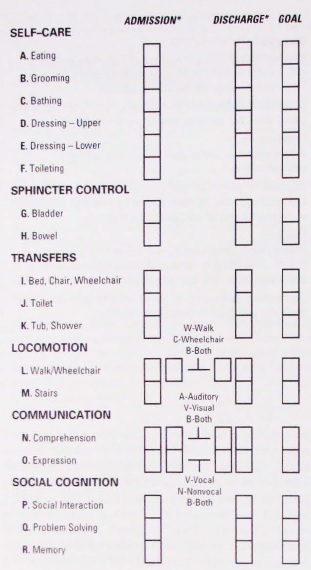Functional Independence Measure (FIM)
Original Editor - Ajay Upadhyay
Top Contributors - Laura Ritchie, Gayatri Jadav Upadhyay, Ajay Upadhyay, Lucinda hampton, Nikhil Benhur Abburi, Kim Jackson, Lauren Lopez, Kapil Narale, Evan Thomas, WikiSysop, Vidya Acharya and Nicole Hills
Objective[edit | edit source]
The Functional Independence Measure (FIM) is an instrument that was developed as a measure of disability for a variety of populations and is not specific to any diagnosis. The FIM instrument
- Includes measures of independence for self-care, including sphincter control, transfers, locomotion, communication, and social cognition[1].
- Is an 18-item, seven-level, ordinal scale intended to be sensitive to changes over the course of a comprehensive inpatient medical rehabilitation program.
- Uses the level of assistance an individual needs to grade functional status from total independence to total assistance).
- The tool is used to assess a patient's level of disability as well as a change in patient status in response to rehabilitation or medical intervention.[2][3]
Intended Population[edit | edit source]
Designed to assess areas of dysfunction in activities that commonly occur in subjects with any progressive, reversible or stable neurologic, musculoskeletal, or other disorder ie patients with functional mobility impairments[4].
Method of Use[edit | edit source]
The FIM is used by healthcare practitioners to assess and grade the functional status of a person based on the level of assistance he or she requires.
FIM™ is comprised of 18 items, grouped into 2 subscales - motor and cognition.
The motor subscale includes:
- Eating
- Grooming
- Bathing
- Dressing, upper body
- Dressing, lower body
- Toileting
- Bladder management
- Bowel management
- Transfers - bed/chair/wheelchair
- Transfers - toilet
- Transfers - bath/shower
- Walk/wheelchair
- Stairs
The cognition subscale includes:
- Comprehension
- Expression
- Social interaction
- Problem solving
- Memory
Each item is scored on a 7 point ordinal scale, ranging from a score of 1 to a score of 7. The higher the score, the more independent the patient is in performing the task associated with that item.
FIM levels
No Helper
7. Complete Independence
(Timely, Safety)
6. Modified Independence
(Device)
Helper - Modified Dependence
5. Supervision
(Subject = 100%)
4. Minimal Assistance
(Subject = 75% or more)
3. Moderate Assistance
(Subject = 50% or more)
Helper - Complete Dependence
2. Maximal Assistance
(Subject = 25% or more)
1. Total Assistance or not Testable
(Subject less than 25%)
Leave no blanks. Enter 1 if not testable due to risk.[2]
The total score for the FIM motor subscale (the sum of the individual motor subscale items) will be a value between 13 and 91.
The total score for the FIM cognition subscale (the sum of the individual cognition subscale items) will be a value between 5 and 35.
The total score for the FIM instrument (the sum of the motor and cognition subscale scores) will be a value between 18 and 126.
Reliability[edit | edit source]
Inter-Rater Reliability of FIM has been established at an acceptable psychometric performance (Intraclass co-relation coefficients ranging from 0.86 to 0.88)
Validity[edit | edit source]
The concurrent validity with Barthel Index (ICC > 0.83), Gosman-Hedstrom and Svenson have shown strong construct validity between items on Barthel Index and items on the FIM the measure functional limitations[5]
References[edit | edit source]
- ↑ Cameron MH, Monroe L. Physical Rehabilitation-E-Book: Evidence-based examination, evaluation, and intervention. Elsevier Health Sciences; 2007 Apr 5.Available: https://www.sciencedirect.com/topics/medicine-and-dentistry/functional-independence-measure(accessed 22.5.2021)
- ↑ 2.0 2.1 Linacre JM, Heinemann JW, Wright BD, Granger CV, Hamilton BB. The structure and stability of the functional independence measure. Arch Phys Med Rehabil. 1994. 75: 127-132.
- ↑ Heinemann AW, Linacre JM, Wright BD, Hamilton BB, Granger C. Relationships between impairment and physical disability as measured by the functional independence measure. Arch Phys Med Rehabil. 1993. 74: 566-573.
- ↑ Elia AE, Graziella F, Albanese A. 12 Clinical Trials of Botulinum Toxin in Adult Spasticity. Botulinum Toxin E-Book: Therapeutic Clinical Practice and Science. 2009 Feb 18:148.Available from: https://www.sciencedirect.com/topics/medicine-and-dentistry/functional-independence-measure(accessed 22.5.2021)
- ↑ Gosman-Hedstrom, G, and Svensson, E: Parallel reliability of the Functional Independence Measure and the Barthel index ADLIndex. Psychiatry 73:188, 2000







